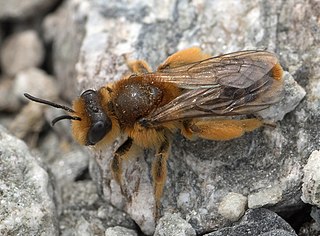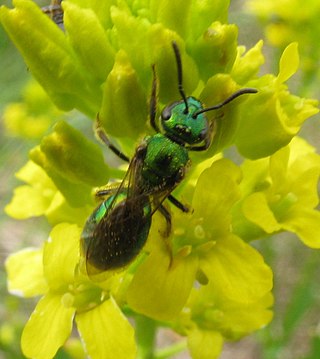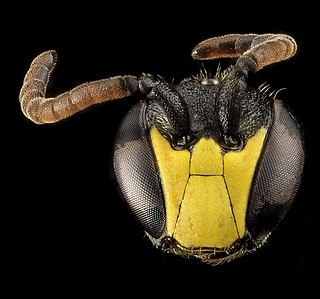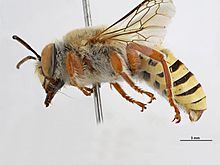
Bees are winged insects closely related to wasps and ants, known for their roles in pollination and, in the case of the best-known bee species, the western honey bee, for producing honey. Bees are a monophyletic lineage within the superfamily Apoidea. They are currently considered a clade, called Anthophila. There are over 20,000 known species of bees in seven recognized biological families. Some species – including honey bees, bumblebees, and stingless bees – live socially in colonies while most species (>90%) – including mason bees, carpenter bees, leafcutter bees, and sweat bees – are solitary.

Carpenter bees are species in the genus Xylocopa of the subfamily Xylocopinae. The genus includes some 500 bees in 31 subgenera. The common name "carpenter bee" derives from their nesting behavior; nearly all species burrow into hard plant material such as dead wood or bamboo. The main exceptions are species in the subgenus Proxylocopa, which dig nesting tunnels in suitable soil.

Halictidae is the second-largest family of bees with nearly 4,500 species. They are commonly called sweat bees, as they are often attracted to perspiration. Halictid species are an extremely diverse group that can vary greatly in appearance. These bees occur all over the world and are found on every continent except Antarctica. Usually dark-colored and often metallic, halictids are found in various sizes, colors and patterns. Several species are all or partly green and a few are red, purple, or blue. A number of them have yellow markings, especially the males, which commonly have yellow faces, a pattern widespread among the various families of bees. The family is one of many with short tongues and is best distinguished by the arcuate basal vein found on the wing. Females in this family tend to be larger than the males. They are the group for which the term 'eusocial' was first coined by entomologist, Suzanne Batra.

The Colletidae are a family of bees, and are often referred to collectively as plasterer bees or polyester bees, due to the method of smoothing the walls of their nest cells with secretions applied with their mouthparts; these secretions dry into a cellophane-like lining. The five subfamilies, 54 genera, and over 2000 species are all evidently solitary, though many nest in aggregations. Two of the subfamilies, Euryglossinae and Hylaeinae, lack the external pollen-carrying apparatus that otherwise characterizes most bees, and instead carry the pollen in their crops. These groups, and most genera in this family, have liquid or semiliquid pollen masses on which the larvae develop.

Hylaeus is a large and diverse cosmopolitan genus within the bee family Colletidae. This genus is also known as the yellow-faced bees or masked bees. This genus is the only truly globally distributed colletid, occurring on all continents except Antarctica.

The Andrenidae are a large, nearly cosmopolitan family of solitary, ground-nesting bees. Most of the family's diversity is located in temperate or arid areas. It includes some enormous genera. One of the subfamilies, Oxaeinae, is so different in appearance that they were typically accorded family status, but careful phylogenetic analysis reveals them to be an offshoot within the Andrenidae, very close to the Andreninae.

Andrena is a genus of bees in the family Andrenidae. With over 1,500 species, it is one of the largest genera of animals. It is a strongly monophyletic group that is difficult to split into more manageable divisions; currently, Andrena is organized into 104 subgenera. It is nearly worldwide in distribution, with the notable exceptions of Oceania and South America. Bees in this genus are commonly known as mining bees due to their ground-nesting lifestyle.

Leioproctus is a genus in the plaster bee family Colletidae. Its members are primarily found in Australasia and temperate South America, and include the most common native bees in New Zealand.

Euhesma is a genus within the bee family Colletidae found in Australia. There are over 90 species described. The group lacks strong unifying features and maybe further split in the future. The type species is Euhesma wahlenbergiae.

Anthidium maculosum is a species of bee in the family Megachilidae, the leaf-cutter, carder, or mason bees. It is a solitary bee where the males are territorial and the females take part in polyandry. The males of A. maculosum differ from most other males of bee species because the males are significantly larger than females. In addition, subordinate males that act as satellites are smaller than territory-owning males. This species can be found predominately in Mexico and the United States.

Sphecodopsis is a genus of cleptoparasitic cuckoo bees in the family Apidae. Endemic to southern Africa, the wasp-like bees of this genus are generally small, varying from 3.9 to 9 mm in length, and mostly black, with orange-ish or reddish colouring of the metasoma in some of the species. The bee genus Scrapter is recognised as a host for the cleptoparasitic life cycle of some Sphecodopsis, but further data regarding preferred hosts is not available for most of the species.

Tetragonula is a genus of stingless bees. In 1961, Brazilian bee expert J.S. Moure first proposed the genus name Tetragonula to improve the classification system by dividing the large genus Trigona stingless bees into 9 smaller groups. About 30 stingless bee species formerly placed in the genus Trigona are now placed in the genus Tetragonula. These bees are found in Oceania, in countries such as Australia, Indonesia, New Guinea, Malaysia, Thailand, the Philippines, India, Sri Lanka, and the Solomon Islands. The most recent tabulation of species listed 31 species.
Elizabeth Morris Exley was an entomologist who researched Australian native bees particularly those in the subfamily Euryglossinae.
Josephine Christina Cardale worked as an entomologist for CSIRO from 1967 to 2001. She was a collection manager of Hymenoptera at the Australian National Insect Collection.

Augochlorella is a genus in the bee family Halictidae, commonly called sweat bees. They display metallic coloration, ranging from reddish to gold to bluish green, as is typical for other genera in the tribe Augochlorini.

Protandrenini is a tribe of mining bees in the family Andrenidae. There are at least 12 genera and at least 380 described species in Protandrenini.

Hylaeus modestus, also known as the modest masked bee, is a species of hymenopteran in the family Colletidae. It is found in North America.

Andrena prunorum, otherwise known as the purple miner bee, is a species of solitary bees in the family Andrenidae. It is commonly found in the continental United States as well as much of North and Central America. Andrena prunorum is a spring-flying, ground-nesting bee that serves as a ubiquitous generalist in ecological settings. Both males and females live as prepupae in the winter in which they mate, and the females seek new sites for ground burrows. From there, they construct small cells surrounding a ball of pollen combined with nectar to nourish a laid egg before each cell is sealed, and the cycle begins anew. A. prunorum generally prefer the pollen derived from Rosaceae plants but will pollinate fruit trees if given the opportunity.

Homalictus is a subgenus of bees in the genus Lasioglossum subfamily Halictinae of the family Halictidae. They are found in Sri Lanka, Southeast Asia, east across the Pacific to the Mariana Islands, Samoa, Fiji and are most prevalent in Australia.

Colletinae is a subfamily of bees belonging to the family Colletidae.

















